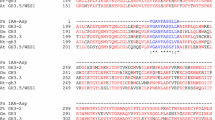Abstract
Indole-3-acetaldehyde oxidase (IAAld-oxidase) occurs in pea in two forms, of which the first, more active enzyme, has its pH optimum at 4.5, while the second, barely half as active, has a pH optimum at 7.0. Only the pH 4.5 oxidase can be resolved from the acetone powder. Besides IAA1d the more stable IA1d was used as substrate in testing the enzymatic activity. The pea enzyme seems not to be a dismutase since indolylmethanol or indolylethanol were not formed as products. Pyridine nucleotide coenzymes did not activate the partially purified enzyme. The pH 4.5 oxidase was inhibited by more than 50 % by IAA > L-asp > tryptophol > indoleacetylaspartic acid > 2,4-D (at 1 mM concentration). The pH 7.0 oxidase was inhibited relatively more weakly, a stronger than 50 % inhibition was caused only by NAA > L-asp. The oxidases were clearly distinguished by the response to L-asparagine (1 mM): the activity of the pH 4.5 oxidase was increased (+ 12 %), while the activity of the pH 7.0 oxidase was decreased (-71 %). In preliminaryin vitro experiments the phytohormones (1 mM) kinetin and GA3 increased the conversion of IAAld to IAA, while ABA decreased it.
Similar content being viewed by others
References
Bower, P. J.: Auxin biogenesis: subcellular compartmentation of indolylacetaldehyde reductases in cucumber seedlings. -Plant Physiol.57: 850–854, 1976.
Bower, P. J., Brown, H. M., Purves, W. K.: Cucumber seedling indoleacetaldehyde oxidase. -Plant Physiol.61: 107–110, 1978.
Bradford, M. M.: A rapid and sensitive method for the quantitation of microgram quantitites of protein utilizing the principle of protein dye-binding. -Anal. Biochem.72: 248–254, 1976.
Brown, H. M., Purves, W. K.: Isolation and characterisation of indole-3-acetaldehyde reductases fromCucumis sativus.-J. biol. Chem.251: 907–913, 1976.
Brown, H. M., Purves, W. K.: Indoleacetaldehyde reductase ofCucumis sativum L. Kinetic properties and role in auxin biosynthesis. -Plant Physiol.65: 107–113, 1980.
El Bahr, M. K., Kutáček, M., Opatrný, Z., Li Sok Nam, Prasad, R.: Changes in L-tryptophan and auxin content during the life cycle of normal and tumorous tobacco cell culture. -Biochem. Physiol. Pflanzen179: 739–748, 1984.
Hais, I. M., Macek, K. (ed.): Handbuch der Papierchromatographie. Band I. Grundlagen und Technik. -VEB G. Fischer Verlag, Jena 1958.
Larsen, P.: 3-Indoleacetaldehyde as a growth hormone in higher plants. -Dansk. Bot. Arkiv11: 1–132, 1944.
Larsen, P.: Conversion of indoleacetaldehyde to indoleacetic acid in excised coleoptiles and in coleoptile juice. -Amer. J. Bot.36: 32–41, 1949.
Larsen, P., Rajagopal, R.: The activity of indole-3-acetaldehyde in relation to that of indole-3-acetic acid in various auxin tests. -In: Regulateurs Naturels de la Croissance Végétale. Pp. 221–223. CNRS, Paris 1964.
Liu, S. T., Katz, C. D., Knight, C. A.: Indole-3-acetic acid synthesis in tumorous and non-tumorous species ofNicotiana. -Plant Physiol.61: 743–747, 1978.
Percival, F. W., Purves, W. K., Vickery, L. E.: Indole-3-ethanol oxidase: kinetics, inhibition and regulation of auxins. -Plant Physiol.51: 739–743, 1973.
Purves, W. K., Brown, H. M.: Indoleacetaldehyde in cucumber seedlings. -Plant Physiol.6: 104–106, 1978.
Rajagopal, R.: Occurrence of indoleacetaldehyde and tryptophol in the extracts of etiolated shoots ofPisum andHelianthus seedlings. -Physiol. Plant.20: 655–660, 1967.
Rajagopal, R.: Occurrence and metabolism of indoleacetaldehyde in certain higher plant tissue under aseptic conditions. -Physiol. Plant.21: 378–385, 1968a.
Rajagopal, R.: Metabolism of indole-3-acetaldehyde. II. On dismutation. -Physiol. Plant.21: 1076–1096, 1968b.
Rajagopal, R.: Metabolism of indole-3-acetaldehyde. III. Some characteristic of the aldehyde oxidase inAvena coleoptile.-Physiol. Plant.24: 272–281, 1971.
Rajagopal, R., Larsen, P.: Metabolism of indole-3-acetaldehyde. IV. Electron acceptor studies and physiological significance of the aldehyde oxidase ofAvena coleoptiles. -In: Carr, D. J., (ed.): Plant Growth Substances 1970. Pp. 102–109. Springer Verlag, Berlin 1972.
Rayle, D. L., Purves, W. K.: Isolation and identification of indole-3-ethanol (tryptophol) from cucumber seedlings.-Plant Physiol.42: 520–524, 1967.
Sahulka, J.: The effect of exogenous IAA and kinetin on nitrate reductase and glutamate dehydrogenase activities in excised pea roots.-Biol. Plant.14: 330–336, 1972.
Schneider, E. A., Gibson, R. A., Wightman, F.: Pathways of auxin biosynthesis in the shoots of higher plants.-In: Carr, D. J. (ed.): Plant Growth Substances 1970. Pp. 82–90. Springer Verlag, Berlin 1972.
Schneider, E. A., Wightman, F.: Auxin. -In: Letham, D. S., Goodwin, R. H., Higgins, R. H. (ed.): Phytohormones and Related Compounds. Pp. 29–105. North Holland Biochemical Press, The Hague 1978.
Suzuki, V., Kamisaka, S., Yanagisawa, H., Miyata, S., Masuda, Y.: Effect of light on growth and metabolic activities in pea seedlings. II. Changes in the IAA content and activities of enzyme involved in the IAA biosynthesis during growth. -Biochem. Physiol. Pflanzen176: 35–44, 1981.
Terziivanova-Dimova, S., Kutáček, M.: Enzymes of auxin biosynthesis and their regulation. I. Tryptophan and phenylalanine aminotransferase. -Biol. Plant., in press.
Vickery, L. E., Purves, W. K.: Isolation of indole-3-ethanol oxidase from cucumber seedlings. -Plant Physiol. 49: 716–721, 1972.
Wightman, E., Cohen, D.: Intermediary steps in the enzymatic conversion of tryptophan to IAA in cell-free systems from mung bean seedlings. -In: Wightman, S., Setterfield, G. (ed.): Biochemistry and Physiology of Plant Growth Substances. Pp. 273–288. The Runge Press, Ottawa 1968.
Author information
Authors and Affiliations
Rights and permissions
About this article
Cite this article
Kutáček, M., Terziivanova-dimova, S. Proposed Enzymes of Auxin Biosynthesis and Their Regulation III. Some Properties of Pea Indolylacetaldehyde Oxidase. Biol Plant 33, 408–416 (1991). https://doi.org/10.1007/BF02897692
Received:
Accepted:
Issue Date:
DOI: https://doi.org/10.1007/BF02897692




